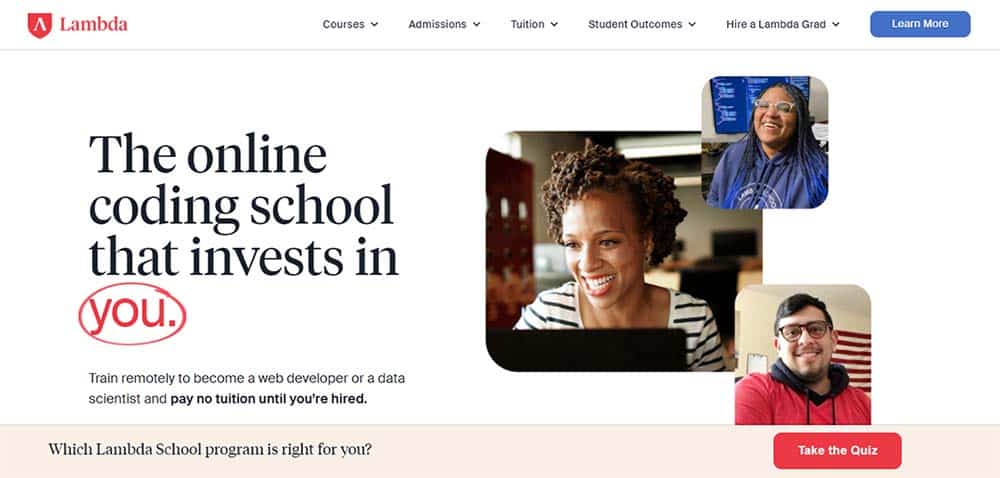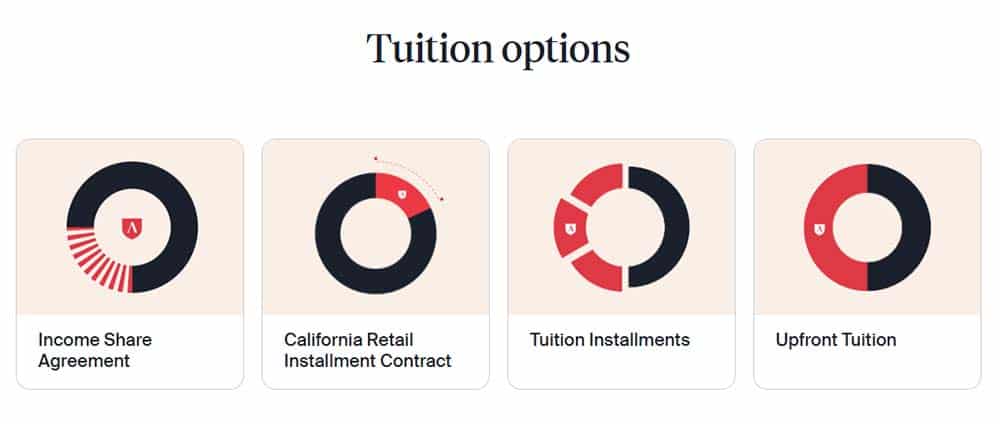Traditional education isn’t cheap. The cost of tuition, books, and accommodation quickly add up to the point where many students have no choice but to take out a loan to pay for their education.
Today, the average student loan borrower in the U.S. has $32,731 in debt. The situation isn’t much better elsewhere in the world, either. In the U.K., students graduate with an average student debt of $30,800, and in Canada, the average student debt is $20,000. Even in Germany, where college tuition is free, most students leave higher education institutions owing around $2,400.
That’s a lot of money, especially when you consider that a college degree no longer guarantees a job. The Federal Reserve Bank of New York says that about a third of all college graduates are underemployed, and almost 10% of recent graduates don’t have a job at all.
What if there was a way of getting a high paid job — in the tech industry no less — without amassing any debt? That’s the thinking that prompted Austen Allred to set up Lambda School in 2017. An online computer science education provider, Lambda School aims to make student debt obsolete by finding “untapped or underutilized talent, and train[ing] that talent for the most in-demand jobs in the world.”
That’s quite a mission statement. But does Lambda School deliver on its promise? Let’s find out.
Table of Contents
What is Lambda School?

According to Lambda’s homepage, Lambda is “the online coding school that invests in you.” The phrase “invests in you” is key here. Unlike most bootcamps and schools that require upfront tuition, Lambda doesn’t charge students until they find a well-paying job in tech.
This innovative approach to education appeals to many people. In October of 2020, the school had about 3,000 students — the student body more than doubled in size since 2019 — and it’s likely that this number has grown considerably since.
It’s not just the lack of up-front costs that attract students to Lambda School. The school’s curriculum is worthy of attention, too.
Currently, Lambda School offers courses in data science and full stack web development. Both courses are live (i.e., you have to physically show up for classes every day), available full-time and part-time, and, thanks to Lambda School’s extensive career services, more or less guarantee a job upon completion.
How does Lambda School work?
The process of studying at Lambda School is different from any other tech education provider or bootcamp we’ve seen.
Lambda School also has both full-time and part-time programs. Those in full-time programs are expected to show up for classes Monday to Friday from 8 am to 5 pm Pacific Time (PT) for 6 months.
On the other hand, those in part-time programs must attend classes Monday to Thursday from 6 pm to 9 pm PT, plus one weekend afternoon (Friday, Saturday, or Sunday) for 12 months. An alternative schedule is available for part-time students, as well. For more information, check out this video explaining the part-time study scheduling process.
In a nutshell, enrolling and studying at Lambda School involves the following steps:
- Submit an application
- Take the assessment
- Finalize your enrollment and attend Lambda Launch
- Attend class and complete a full “sprint”
- Do the sprint challenge
- Repeat a sprint if necessary
- Participate in Build Week
- Take part in Lambda Labs
- Get your certificate of completion
1. Submit an application
The first step is registering for a Lambda School account and submitting an application. Here, Lambda School will ask you for things like your name and email address, the computer science course you’re interested in, and when you want to start class.
2. Take the assessment

To make sure that you’re a good fit for their program, each student is required to take an assessment. This assessment measures your verbal, math/logic, and spatial reasoning.
Those applying for the Data Science program will need to complete a “skills challenge,” as well. Some students may also have to submit a video interview (the interview process depends on the country/state you live in) and show proof of past educational achievement.
3. Finalize your enrollment and attend Lambda Launch
If you’re accepted into Lambda School, you’ll be asked to choose your start date and sign documentation.
Full stack web development students will also need to take a coding assessment so that Lambda School can better understand their current skills level. All students need to attend Lambda Launch, mandatory student orientation.
4. Attend class and complete a full “sprint”
On the first day of Lambda School, you are sorted into a team, meet your team lead (more on them below), and are introduced to what a typical workflow looks like. Then, the fun begins!
The curriculum at Lambda School is divided into units, which are further split into “sprints.” It takes one week to complete a sprint for a full-time program and two weeks for a part-time program.
Although the daily schedule depends on your chosen program and may differ from unit to unit, this is what you can expect:
- 8 am to 9 am. Review the day’s material and objectives and watch a few pre-recorded videos that go over the basics of what you’ll learn that day.
- 9 am to 11 am. Live lecture with instructors, project managers, and other students.
- 11 am to 12 pm. Lunch break.
- 12 pm to 3.45 pm. Project time! Daily projects test the concepts you learned in the morning. If you don’t complete your project during this period, you’re expected to finish it in your own time.
- 3.45 pm to 4.15 pm. Complete a survey about your progress.
- 4.15 pm to 5 pm. Meet with your Project Manager and a small group of fellow students to receive code reviews, ask any questions, and talk about what went well and what didn’t.
For a more comprehensive look at a day in the life of a Lambda School student, read Anthony J. Campbell’s blog or check out Christian Helms’ Lambda School YouTube series. And, here’s an example of Lambda School’s online lectures.
5. Do the sprint challenge
When you get to the end of a sprint, you have to complete a sprint challenge. This challenge takes place every Friday and tests your knowledge of all the concepts you learned in that particular sprint. You have three hours to complete the challenge.
The challenge is reviewed by your team leader and instructors. If you don’t pass the challenge, you have to meet with your team lead and talk about the next steps. You may have to work extra hours, or you may have to flex, which means you have to repeat the sprint.
6. Repeat a sprint if necessary
Having to flex is not the end of the world. When it comes to web development and data science, it’s about making sure you have the skills you need to succeed in the real world, not ticking boxes.
7. Participate in Build Week
At the end of each unit, you are assessed once again. This time around, the evaluation lasts four days. These four days are known as “Build Week.”
At the start of this week, you’re assigned to a small team that consists of students from other programs and cohorts. Your goal? To build a minimum viable product (MVP).
8. Take part in Lambda Labs
At the end of the program, you participate in an in-house apprenticeship (Lambda Labs) where you build a real-world project in a small team.
The product may be developed for an internal or external client. For example, one Lambda School student and his team had to create a data visualization tool for a non-profit organization in Africa.
9. Get your certificate of completion
When you finish the program, you receive a certificate of completion. Now, it’s time to start looking for a job. Luckily, you’re well prepared (career services at Lambda School start at week two). Moreover, Lambda School is there to support you every step of the way, securing you interviews and even helping you negotiate.
Reviewing Lambda School's income share agreements
Instead of paying tuition, most individuals who enroll at Lambda School sign an income sharing agreement (ISA). An alternative to student loans, ISAs obligate students to pay a percentage of their future income.
When you sign an ISA with Lambda School, you agree to pay 17% of your gross salary for 24 months after landing a job in tech — but only if you’re making $50,000 or more a year. The total payments are capped at $30,000.
If, after 60 months of deferred payments, you still haven’t been hired in a tech position, you don’t have to pay — ever. Similarly, if you secure a job but then leave or lose it, Lambda School pauses payments without charging interest.
Note that ISAs are only available to people that live in the U.S. and are U.S. citizens, U.S. permanent residents, or DACA recipients.
Those that reside in California are not eligible for ISAs. Instead, they can avail of other financing options, most notably the California Retail Installment Contract (RIC). The difference between the RIC and the ISA is that Californian students will have to repay $30,000, regardless of how long it takes.
According to some reports, Lambda School may sell at least some of its students’ ISAs to investors, which seems to contradict the school’s claim that it only makes money when its students make money.
How much does Lambda School cost?
If you don’t want to defer tuition, you can pay the full tuition upfront or in three installments.
Tuition depends on the state students live in. For students residing in Washington DC, California, Texas, and Georgia, tuition is $30,000.
In contrast, for students residing in all other states and countries other than the U.S., tuition is $15,000.

Review of Lambda School courses
At the moment, Lambda School offers two programs:
Let’s take a look at each one in turn.
Lambda School Full Stack Web Development Course
Lambda School’s Full Stack Web Development Course teaches you both front-end development (designing the part of the website that users interact with) and backend development (working behind the scenes of what happens when users interact with a website).
To that end, students learn languages for front-end development (i.e., Javascript and React) as well as languages for backend development (Java and Python). After graduating, students can find jobs in computer science, software engineering, mobile development, and backend technologies.
The program is organized into the following topics:
- Web Foundations: HTML, Javascript, CSS, Git, and UI Principles.
- Web Application Development: React, Redux, and Ajax.
- Advanced Web Development: Advanced React.
- Back End Development: Basics of Java or Node.
- Computer Science: Python and object-oriented programming.
- Labs: Building a real-world project as part of a small team.
Once you complete the entire course, you receive ongoing support for your job search in computer science, software engineering, or another computer science field by Lambda School.
Lambda School Data Science Course
Lambda School’s Data Science Course teaches you how to analyze data, organize and store data using data structures, and communicate your insights, among other things.
Those who complete this course may go on to become data analysts, data scientists, machine learning engineers, business analysts, and digital marketing managers.
The program is organized into the following topics:
- Statistics Fundamentals: Data wrangling, linear algebra, and statistical tests.
- Predictive Modeling: Linear models, model comparison, and applied modeling.
- Data Engineering: SQL and databases.
- Machine Learning: Natural language processing as well as neural network foundations.
- Computer Science: Python and object-oriented programming, algorithms, and data structures.
- Labs: Building a real-world project as part of a small team.
Similar to the Full Stack Web Development course, at the end of this course, students receive extensive career help to find an entry-level job.
The advantages (Pros) of Lambda School
Lambda School has many advantages over its competitors. Below are just some of them.
No upfront fees
The main thing that draws most students to Lambda School is its ISAs. Students that sign an ISA don’t have to pay tuition up front. Rather, students pay 17% of their salary when they get a job that pays $50,000 a year or more.
Furthermore, with the exception of California residents, graduates who don’t find employment within 60 months will owe nothing.
As founder Allred said in a Medium post, “If we promise someone that our education will help them get a job, and we’re wrong about that, why should we be paid?”
Full-time and part-time courses
Lambda School offers both full-time and part-time courses.
If studying eight hours a day five times a week isn’t feasible for you, you can always opt for the part-time option. At three hours a day for five days, it’s a much more reasonable option for students with other responsibilities.
Well-built curricula
Each program’s curriculum is designed with input from industry leaders and hiring managers who work in computer science, software engineering, and other tech areas. The curriculum also includes a ton of real-world projects to mirror what students will encounter in the workplace.
Constantly innovating
Over the years, Lambda School has introduced quite a few changes, including new instruction methods and even the Living Stipend Program (an initiative that has been paused for the time being).
Although students haven’t been happy with all of the changes made, constant innovation is a sign that Allred and his team actively listen to and incorporate student feedback into the way they run the school.
An opportunity to make money
Lambda School is incredibly demanding. If you choose to enroll in one of its full-time programs, chances are you won’t have the opportunity to also work, even part-time. This may be an issue for students in a financially tight position.
However, one of Lambda School’s financing options is becoming a team lead. The primary role of a team lead is to facilitate team discussions, check in with other students, take attendance, and answer questions. Team leads get paid roughly $13 an hour.
High student career success rate
As a Lambda School alumni, you won’t have to fend for yourself in the job market. Thanks to Lambda Schools’ career-centric curriculum (think things like resume building and mock interviews) and hiring partnerships, Lambda School students have a high chance of finding a tech job.
According to the Lambda School Outcomes Report, of the 284 students who graduated from Lambda School in 2019, 79% found a job. Of these, more than half were placed in jobs within 90 days of graduation, and more than 80% reported an annual salary of over $50,000. Some Lambda School graduates are now working for Fortune 100 companies and top startups, like Google, Microsoft, Goldman Sachs, IBM, Hubspot, and Coinbase.
The disadvantages (cons) of Lambda School
No online education provider or bootcamp is perfect. There are quite a few improvements Lambda School could make to enhance its offering.
Highly competitive
The rigorous application process means that not everyone who wants to get into Lambda School is accepted. Indeed, according to Lambda School, only 7% of all applicants are admitted into each cohort.
Large cohorts
Most of the cohorts at Lambda School are quite large. Students have reported being in cohorts made up of between 40 to 100 students. Large cohorts make it more difficult to receive feedback.
Review Conclusion: is Lambda School worth it?
Lambda School isn’t for everyone, that’s for sure. As far as online tech education providers go, it’s not flexible, which is bound to put off a lot of people. The structure is rigorous and, regardless of whether you choose the full-time or part-time program, the months that follow are bound to be difficult and exhausting.
However, that’s exactly what makes Lambda School so great. It’s not easy, but it’s rewarding. In the end, you’re there to learn and be challenged.
Lambda School teaches you computer science fundamentals in six months (or a year if you do it part-time). Therefore, your opportunity cost is a fraction of what it would be if you pursued a traditional computer science program at a university.
Moreover — and this is crucial — Lambda School doesn’t charge any fees upfront. You only have to pay tuition if and when you get a job. If you don’t get a job in tech, you don’t have to pay anything (unless you’re based in California or live outside the U.S.).
That being said, career outcomes for Lambda students are beyond impressive. To quote Allred, “If you are a student who shows up and works hard, we will never give up on you. Ever.” For aspiring software engineers and data scientists, these are motivating words to hear.



